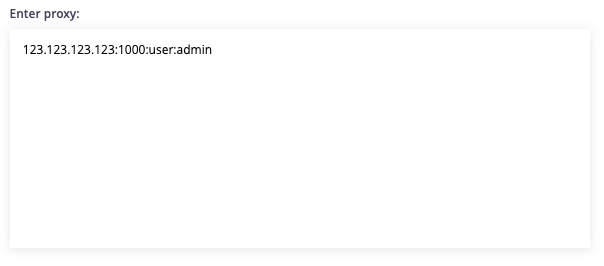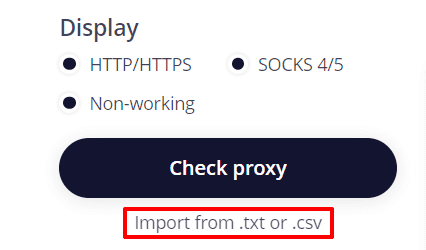IPv4
From $0.72 for 1 pc. 37 countries to choose from, rental period from 7 days.
IPv4
From $0.72 for 1 pc. 37 countries to choose from, rental period from 7 days.
IPv4
From $0.72 for 1 pc. 37 countries to choose from, rental period from 7 days.
IPv6
From $0.07 for 1 pc. 14 countries to choose from, rental period from 7 days.
ISP
From $1.35 for 1 pc. 23 countries to choose from, rental period from 7 days.
Mobile
From $14 for 1 pc. 20 countries to choose from, rental period from 2 days.
Resident
From $0.70 for 1 GB. 200+ countries to choose from, rental period from 30 days.
Use cases:
Use cases:
Tools:
Company:
About Us:
Proxies are essential tools for maintaining privacy, scaling within platform limitations, and managing multiple online tasks efficiently. However, not every intermediary performs as expected. Some may be slow, blocked, or expose your real IP address. This is why it is important to know how to test proxies before relying on them for sensitive work. Reliable testing methods help confirm that each IP is secure, stable, and suitable for its intended purpose. These testing approaches apply to both paid and free proxy servers, since quality and performance can vary greatly depending on the source. By testing, you can quickly identify which IPs are suitable for secure browsing, data collection, or platform-specific operations.
Testing and verifying proxy connections is not only a technical step but also essential for maintaining privacy and stable performance online. By taking time to check proxy settings, users can avoid common issues such as poor browsing speed, service incompatibility, or even security leaks. Invalid or poorly configured IPs can result in websites detecting your true IP address. This may lead to data leaks, account limitations, or even bans. They can also slow down internet speed significantly, wasting time and reducing productivity. Some of the key reasons why users need to check if proxy is working include:
Regular testing ensures that the intermediary remains efficient, safe, and well-suited for specific online activities, from web scraping to secure browsing.
When learning how to check proxy, it is important to understand which metrics matter most. Testing not only confirms if an intermediary responds but also evaluates its quality. The following factors should be considered:
This measures how quickly the intermediate server replies to a connection request. A shorter response time means better performance and less waiting during browsing or data tasks. For example, an intermediary with a response time of under 200 ms will usually feel smooth in everyday browsing, while slower new IPs may cause noticeable delays.
Testing speed helps identify how much bandwidth is available when using the server. Proxies with poor connection speed can interrupt tasks like streaming, scraping, or automation. A consistent high-speed intermediate server is necessary for large-scale data operations or for users who need reliable video playback.
Not all intermediaries provide the same level of privacy. Tests can reveal whether the new IP is transparent (shows your IP), anonymous (hides your IP but reveals it is a server), or elite/high-anonymity (fully hides both). Choosing the right anonymity level depends on the task: for example, scraping projects often require elite proxies to avoid detection.
Checking the geographical location of the server is crucial. It affects access to region-specific platforms and influences connection speed depending on server proximity. An intermediary located near your target region generally provides faster response and lower latency. When verifying this, you can also confirm how to check proxy addresses to ensure accuracy.
Some IPs may be blacklisted due to previous misuse. Running a test against spam databases ensures the new IP is not blocked, reducing the chance of website restrictions. This is especially important when handling accounts or services that enforce strict anti-spam policies.
Even a fast, anonymous intermediate server is not useful if it fails to work with the websites or applications you need. Testing helps confirm that the new IP can interact correctly with targeted services. For example, an intermediary that works well on Google may still fail when used for social networks, so compatibility tests are essential.
There are several proven methods to test if proxy is working. Each option has its advantages, depending on technical skills and requirements. Below are the most reliable approaches.
Online IP checkers are the simplest method for both beginners and professionals. These tools confirm whether your intermediate server masks your real IP address and provide detailed information such as location, speed, and anonymity level. A practical solution is instant proxy checker tool, which allows users to verify servers quickly without installing additional software. It supports different intermediary formats, including private and public proxies, and delivers results in seconds.
To use an IP checker, follow these steps:





This process shows how to test proxy connection effectively and ensures that the chosen server meets your needs. If certain servers fail during this step, it may be necessary to buy proxy access from a trusted provider to maintain reliability.
Another way to how to check my proxy server is to verify whether its IP appears in global databases. These databases collect information about suspicious or blocked IPs, often used by websites to filter traffic. Testing against IP databases can confirm whether a new IP is blacklisted (which you can check using our IP Blacklist Check tool), which is especially useful for tasks like social media management or SEO monitoring. However, one limitation is that some databases may not update in real time. This means results can occasionally be outdated, and an intermediary marked as safe may still be blocked by certain services. Despite this, database checks remain a valuable step when you want to how to test if proxy is working across different online platforms.
Advanced users may choose to develop their own methods for testing servers. Instead of relying on external tools, it is possible to create custom scripts or software that automatically checks a server’s response time, anonymity, and overall availability. This approach is useful when managing large IP lists because it allows full control over the testing process. Automated checks can confirm whether the new IP hides the original IP address, responds within acceptable time limits, and works with targeted websites. Although this method requires technical knowledge, it provides flexibility and accuracy. Businesses and developers who depend on multiple servers often prefer custom testing since it can be integrated into larger systems or automated workflows.
Knowing how to test proxies is critical for maintaining anonymity, ensuring connection quality, and avoiding blocked or invalid servers. Whether you use online IP checkers, spam databases, or custom testing methods, proper validation protects your data and improves performance. By checking response time, speed, anonymity, and location, you can select the most suitable IPs for your specific needs. Regular testing also ensures that intermediaries remain secure and functional over time. In addition, verifying that servers are not listed in spam databases and remain compatible with target platforms prevents unnecessary disruptions. From beginners who simply want to hide their IP to advanced users running automated systems, every internet user benefits from reliable server testing methods. When these methods are applied consistently, they guarantee stable, private, and efficient browsing experiences that support both personal and business requirements.
